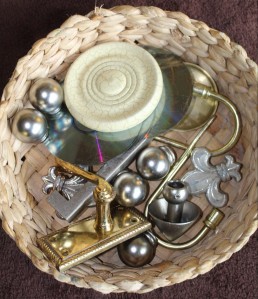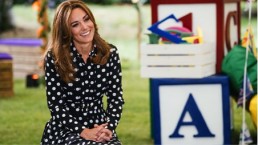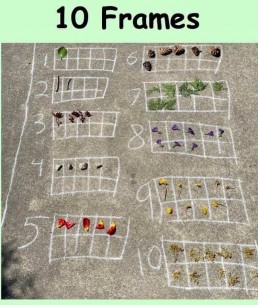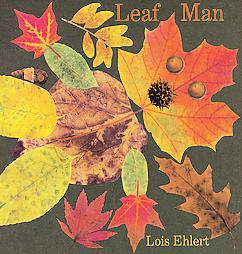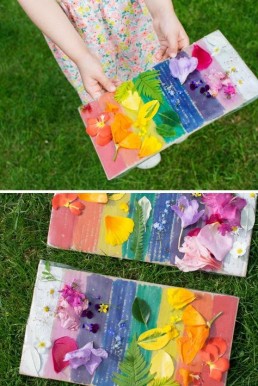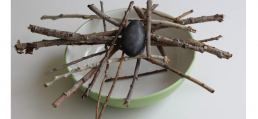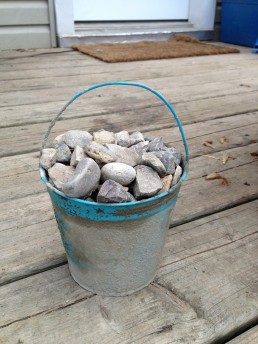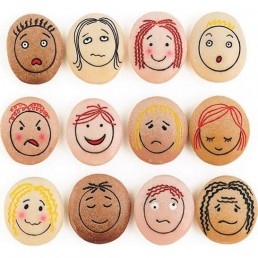Loose Parts
Why do we use loose parts?
Loose parts are a significant segment of our ethos at Inspirations Nurseries. Before moving away from conventional toys, we did a lot of research into the benefits of using loose parts. Several education pedagogies use loose parts. Reggio Emilia and loose parts complement each other well; we use both at Inspirations. Both philosophies support open ended play using natural resources, imagination, and creativity. When children are given opportunities to engage in free play with little adult direction, they are able to explore freely with creativity and expression, because there are no limitations or expectations.

What are Loose Parts?
Loose parts are open ended materials that can be moved around, designed, and redesigned. They create opportunities to use our imaginations and discover new ideas. Conventional toys are fixed for the one purpose they were made for, whereas loose parts are open ended and can be used for a variety of things. A plastic car can only be a car. A stick could be a magic wand or a person or you could use a number of them to make a house… the possibilities are endless. Ask any parent how long their children will play with the cardboard box a toy comes in on their birthdays. Loose parts can be found anywhere. How many of us remember going to the beach and collecting shells and stones and making patterns with them? You can find loose parts in the house, in the garden or on a walk. Loose parts include both manufactured and natural resources. These can include stones, pinecones, rings, balls, blocks, boxes, leaves and even nuts and bolts.


Endless Possibilities
For outdoor play, we provide a variety of large loose parts such as tyres of different sizes, milk crates, planks of wood, cable reels etc. In our baby rooms, we use a variety of loose parts to support schemas; we use things like curtain rings to hang on mug trees, balls to post through holes, tyres to encourage rolling. Toddlers can then use slightly smaller loose parts such as pebbles to create patterns and smaller wood slices for counting. Preschool are able to use more intricate loose parts such as beads, small tiles and items they find on forest school.
The founder of the Reggio Emilia Philosophy said...
“Children need the freedom to appreciate the infinite resources of their hands, their eyes and their ears, the resources of forms, materials, sounds and colours”.
-Kayleigh
See loose parts in action in our Pre-School room here- https://youtu.be/Nngfh6Uj-yw
All photos from Inspirations Nursery
Tiny Happy People
The Duchess of Cambridge is once again shouting out for children in their early years by supporting the BBC’s Tiny Happy People programme.
The BBC website offers suggested activities and play ideas for babies and toddlers with an aim of enhancing their language and communication skills. With the tag line: ‘Your words build their world’
Here at Inspirations we understand the importance of children’s communication development. If a child has a deep knowledge of words and language, they are better enabled to understand the world around them. We support our youngest children through songs and rhymes which is a brilliant way to engage young children in the rhythms and tone of speech. We have a ‘Babies Can Sign’ specialist in weekly to teach the educators and children sign language. Sign language is a visual aid (so are pictures in books etc) which enhances a child’s understanding of words before they are even able to talk! This gives them a head start in understanding words and their meaning. Reading books with a supportive adult and using the pictures as a tool to support understanding is also a vital in developing a child’s communication skills.
We also ensure that we make eye contact when talking to children, at a level where the child can see your face clearly, this allows the child to gain an understanding of nonverbal communication, it gives the child the ability to understand the emotions behind the words and also the way the mouth shapes make the different sounds. Eye contact and close physical contact for babies and toddlers is also essential for them to feel safe and secure. Humans don’t learn, if they are feeling insecure or unsafe. Maybe this is why baby wearing has taken off in such a big way in recent years.
Our ethos of ‘enabling environments’ and the offering of a variety of different activities including messy play, singing and signing, water play, light and shadow exploration and of course our outdoor areas, (which gives the children the experiences of different weather types), when supported by a vocal caring adult expands and enhances each child’s exposure to new vocabulary, intonation and rhythm of speech.
For further information on the Duchess of Cambridge’s collaboration with the BBC please and also some fantastic activity ideas for you to do with your child, follow the link to the website. https://www.bbc.co.uk/tiny-happy-people
Inclusion, Diversity and Equality
 British society is filled with colourful diversity, a rainbow of religions, cultures, languages, foods, festivals, music and celebrations all witnessed on streets around the United Kingdom. We are truly privileged to live in such a diverse and colourful environment.Read more
British society is filled with colourful diversity, a rainbow of religions, cultures, languages, foods, festivals, music and celebrations all witnessed on streets around the United Kingdom. We are truly privileged to live in such a diverse and colourful environment.Read more
Number Frames
Resources – chalk, spring finds, or alternatively pens and paper
Implementation
Draw 10 grids of 10 boxes and number them 1 to 10. Add the amount of items to match the corresponding numbers into the boxes.
If your child is working on numbers to 5 just draw 5 boxes, similarly if your child is working beyond 10 add more larger boxes.
Intent- Learning Goals
Maths – Numbers
30-50 months
- Uses some number names and number language spontaneously.
- Uses some number names accurately in play.
- Recites numbers in order to 10.
- Knows that numbers identify how many objects are in a set.
- Beginning to represent numbers using fingers, marks on paper or pictures.
- Sometimes matches numeral and quantity correctly.
- Shows curiosity about numbers by offering comments or asking questions.
- Shows an interest in number problems.
- Shows an interest in numerals in the environment.
- Shows an interest in representing numbers.
40-60 months
- Recognise some numerals of personal significance.
- Recognises numerals 1 to 5+
- Counts up to three or four objects by saying one number name for each item.
- Counts actions or objects which cannot be moved.
- Counts objects to 10 and beginning to count beyond 10.
- Counts out up to six objects from a larger group.
- Selects the correct numeral to represent 1 to 5, then 1 to 10 objects.
- Counts an irregular arrangement of up to ten objects.
- Estimates how many objects they can see and checks by counting them.
- Uses the language of ‘more’ and ‘fewer’ to compare two sets of objects.
- Says the number that is one more than a given number.
- Records, using marks that they can interpret and explain.
- Begins to identify own mathematical problems based on own interests and fascinations.
Make your own Leaf Man
Resources: Leaves, paper, glue,
Implementation
Lots of children have been sharing their leaf play and discoveries with us. We hope you enjoyed our Leaf Man story read by Nicola, you can find it here-
https://www.youtube.com/watch?v=NLEMeqLITwo&t=20s
Go for a walk and look for Autumn leaves and have a go at making your own Leaf Man, don't forget to ask your children some questions along the way. Below we have listen the criteria of learning development this activity meets.
- What does Leaf Man look like?
- Who will you make?
- What will you need?
- What could you use to make their face?
Intent – Learning Goals
Moving and Handling
22-36 months
- Shows control in holding and using jugs to pour, hammers, books and mark-making tools.
- Beginning to use three fingers
30-50 months
- Uses one-handed tools and equipment
40-60 months
- Uses simple tools to effect changes to materials.
- Handles tools, objects, construction and malleable materials safely and with increasing control.
Literacy
22-36 months
- Has some favourite stories, rhymes, songs, poems or jingles
30-50 months
- Describes main story settings, events and principal characters.
- Shows interest in illustrations and print in books and print in the environment.
40-60 months
- Uses vocabulary and forms of speech that are increasingly influenced by their experiences of books.
- Enjoys an increasing range of books.
Being Imaginative
22-36 months
- Beginning to use representation to communicate, e.g. drawing a line and saying ‘That’s me.’
30-50 months
- Captures experiences and responses with a range of media, such as music, dance and paint and other materials or words.
40-60 months
- Create simple representations of events, people and objects.
Exploring and using media and materials
30-50 months
- Joins construction pieces together to build and balance.
- Realises tools can be used for a purpose.
40-60 months
- Understands that different media can be combined to create new effects.
- Manipulates materials to achieve a planned effect.
- Constructs with a purpose in mind, using a variety of resources.
- Uses simple tools and techniques competently and appropriately.
- Selects appropriate resources and adapts work where necessary.
- Selects tools and techniques needed to shape, assemble and join materials they are using.
Spring Colour Hunt
Resources: Pens or paints, paper/card, glue and natural loose parts

Implementation
Paint some colours or a rainbow onto paper, see how many natural items you can find outdoors to match the colours, then stick them to the matching colour. There are some beautiful spring colours to find at the moment.
What colours do you have to use?
What colour would you like to have?
What colours could you mix to make this colour?
What colours did you find?
What colour items did you find the most of?
What else can you see in the environment that are these colours?
Intent – Learning Goals
Expressive Arts and Designs – Exploring and using media and materials
22-36 months
- Experiments with blocks, colours and marks.
30-50 months
- Explores colour and how colours can be changed
40-60
- Explores what happens when they mix colours
Understanding the World – The world
22-36 months
- Notices detailed features of objects in their environment.
30-50 months
- Comments and asks questions about aspects of their familiar
- world such as the place where they live or the natural world.
- Can talk about some of the things they have observed such as plants, animals, natural and found objects.
- Developing an understanding of growth, decay and changes over time.
40-60 months
- Looks closely at similarities, differences, patterns and change.
Leaf Weaving
Resources – sticks, leaves and string
Implementation
This activity needs a lot of focus, time and adult support when needed, but is a great activity to encourage concentration and fine motor control. It can be made simpler with less string to thread through.
Make a square with the sticks and string, then tie lengths of string across to weave the leaves through. There are lots of leaves around of varying colours to make colour patterns, what do you observe when you look through it at the sun?
Intent – Learning Goals
Characteristics of Effective Learning
Being involved and concentrating
- Maintaining focus on their activity for a period of time
- Showing high levels of energy, fascination
- Not easily distracted
- Paying attention to details
- Finding ways to solve problems
- Finding new ways to do things
Keeping on trying
- Persisting with activity when challenges occur
- Showing a belief that more effort or a different approach will pay off
- Bouncing back after difficulties
Enjoying achieving what they set out to do
- Showing satisfaction in meeting their own goals
- Being proud of how they accomplished something – not just the end result
- Enjoying meeting challenges for their own sake rather than external rewards or praise
Making links
- Making links and noticing patterns in their experience
- Making predictions
- Testing their ideas
- Developing ideas of grouping, sequences, cause and effect
Choosing ways to do things
- Planning, making decisions about how to approach a task, solve a problem and reach a goal
- Checking how well their activities are going
- Changing strategy as needed
- Reviewing how well the approach worked
Finding out and exploring
- Showing curiosity about objects, events and people
- Using senses to explore the world around them
- Showing particular interests
Being willing to ‘have a go’
- Seeking challenge
- Showing a ‘can do’ attitude
- Taking a risk, engaging in new experiences, and learning by trial and error
Stick and Stone Balancing Activity
Resources – Sticks, a stone and a bowl
Implementation
Use your problem solving and fine motor skills to lay your sticks out and balance the stone so it doesn’t fall through into the bowl. As a challenge limit the amount of sticks and use a smaller stone!
Intent – Learning goals
Characteristics of Effective Learning
Playing and Exploring –
Being willing to ‘have a go’
- Initiating activities
- Seeking challenge
- Showing a ‘can do’ attitude
- Taking a risk, engaging in new experiences, and learning by trial and error
Active Learning –
Being involved and concentrating
- Maintaining focus on their activity for a period of time
- Showing high levels of energy, fascination
- Not easily distracted
- Paying attention to details
Keeping on trying
- Persisting with activity when challenges occur
- Showing a belief that more effort or a different approach will pay off
- Bouncing back after difficulties
Enjoying achieving what they set out to do
- Showing satisfaction in meeting their own goals
- Being proud of how they accomplished something – not just the end result
- Enjoying meeting challenges for their own sake rather than external rewards or praise
Creating and Thinking Critically
Having their own ideas
- Thinking of ideas
- Finding ways to solve problems
- Finding new ways to do things
Making links
- Making predictions
- Testing their ideas
Choosing ways to do things
- Planning, making decisions about how to approach a task, solve a problem and reach a goal
- Checking how well their activities are going
- Changing strategy as needed
- Reviewing how well the approach worked
Stone Trajectory
Throwing stones can be a great learning experience but remember to always make sure you have enough space around you so you don’t hit anyone or anything else!
Implementation
Place a bucket a short distance away from you and see if you can gently throw the stone underhand into the bucket. If this becomes easy for you then start to move the bucket a little further away. You can count how many stones you get into the bucket or you could number the stones and throw them in in order. As an extension you could have two buckets and share the stones equally between them.
 Intent- Learning Goals
Intent- Learning Goals
Trajectory Schema is an interest in lines and movement. This is a nice way to say your child keeps throwing things around the room or repeatedly dropping food from their highchair. Small babies begin to work on this schema when they track movement with their eyes and reach in front of them to grasp objects. They soon move on to dropping and posting items as they discover the world around them and how they can influence it. Toddlers exploring this path of development will favour activities that involve throwing objects
A great way to support this schema is to set up opportunities for posting and throwing.
- Cut holes in a cardboard box and let your little one post balls and toys into the holes.
- Set up different sized cardboard tubes for your child to post pompoms or cotton balls into.
- Give your child a variety of different object to throw or drop from a height and listen to the sounds they make when they land.
- Make ‘targets’ by drawing out circles on the ground outdoors or using buckets. Allow your child to throw toys, balls or even stones to hit the targets. This is a great exercise to work on their gross motor skills and get some of the throwing urges out of their system. Just make sure you move any breakables!
Physical Development – Moving and Handling
- Talk with children about the need to match their actions to the space they are in.
- Show children how to collaborate in throwing, rolling, fetching and receiving games
- Explain why safety is an important factor in handling tools, equipment and materials, and have sensible rules for everybody to follow.
22-36 months
- May be beginning to show preference for dominant hand.
40-60 months
- Shows increasing control over an object in pushing, patting, throwing, catching or kicking it.
Maths - Numbers
30-50 months
- Uses some number names accurately in play.
- Recites numbers in order to 10.
- Knows that numbers identify how many objects are in a set.
- Compares two groups of objects, saying when they have the same number.
40-60 months
- Recognises numerals 1 to 5+
- Counts objects to 10, and beginning to count beyond 10.
Impact
How did this activity go? Please use this space to record any findings, adaptions, reflections and quotes from your children. We would love you to email them back to us or share them on Tapestry, Instagram or Facebook.
Feelings Stones
Resources: Stones, pens/paint
For the body- Clay, mud, play dough or sticks
Implementation
In these unprecedented times we are all aware how important it is to be extra aware and look after our well being. Your children could use play dough to make a body and parents or children could draw pictures of a range of emotions on stones, so then each day your child can choose how they are feeling and talk about that emotion and the reasons why.


Intent- Learning Goals
Personal Social and Emotional Development – Managing feelings and behaviour
22-36 months
- Can express their own feelings such as sad, happy, cross,scared, worried.
30-50 months
- Aware of own feelings, and knows that some actions and words can hurt others’ feelings.
Personal Social and Emotional Development – Self confidence and self awaremess
22-36 months
- Expresses own preferences and interests.
30-50 months
- Can select and use activities and resources with help.
- Welcomes and values praise for what they have done.
- Enjoys responsibility of carrying out small tasks.
- Shows confidence in asking adults for help.
40-60 months
- Confident to speak to others about own needs, wants, interests and opinions.
- Can describe self in positive terms and talk about abilities.
Communication and Language – Speaking
22-36 months
- Uses language as a powerful means of widening contacts, sharing feelings, experiences and thoughts.
40-60 months
- Uses talk to organise, sequence and clarify thinking, ideas, feelings and events.
Impact
How did this activity go? Please use this space to record any findings, adaptions, reflections and quotes from your children. We would love you to email them back to us or share them on Tapestry, Instagram or Facebook.
